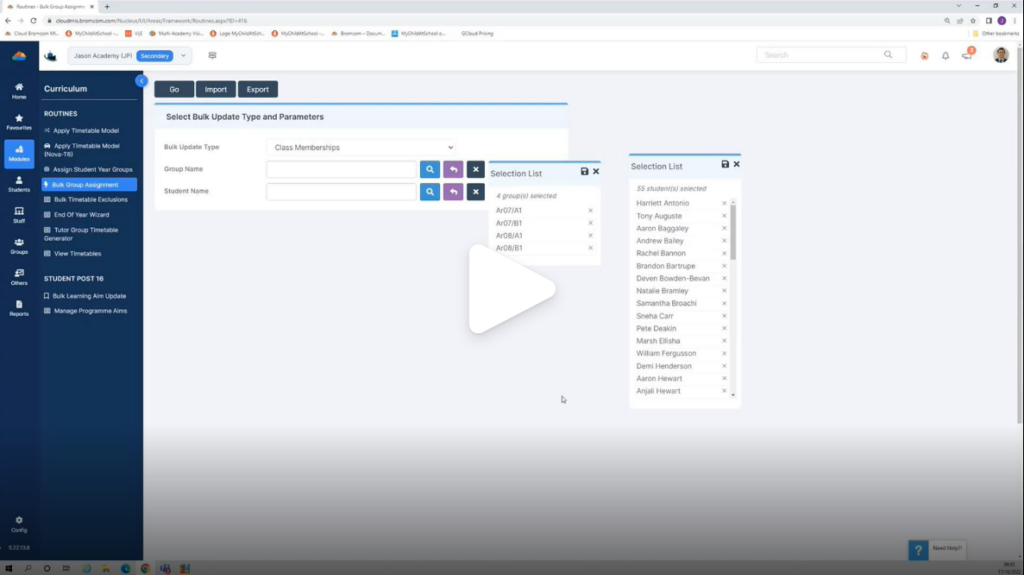Who doesn’t love a debate on social media? It seems the world of Edtech is no different. Schools, MATs, LAs and Edtech bods, take to various channels to argue over how schools are best served in the modern age.
Whilst it’s great to see so much interest in Education and how it can be supported by technology, all this debate can be a little overwhelming. How does any of this impact school life and the pupils we are dedicated to?
Let’s demystify some of the key themes that are discussed on social media as they play a key role when evaluating software.
Functionality vs Features
‘Isn’t choosing an MIS is just a checkbox exercise?’
We meet so many schools that have a checklist of required features, carried over from what they already have. Broadly speaking, features are the tools you have in your system. In the context of MIS, this could be your Parent Communications module, Assessment module and so on.
The problem with this approach is that it doesn’t consider what you want to achieve. For example, rather than having a simple requirement for a Parent Communications module, what if you were to ask for a solution that:
- Shares a wide range of information with parents in real time
- Provides two-way communication tools
- Boosts parental engagement with the school
- Encourages learning outside of the school gates
Doesn’t that sound a bit more exciting than being able to text a parent? This is the power of buying based on functionality. You’re presenting the problems you want to have solved and priming the supplier to demonstrate how they can overcome them.
On a recent demo to a MAT, a member of our team realised that their schools were spending several days on class promotions at the end of the year. It was something they were frustrated by, but it wasn’t until a chance discussion that it came up.
We were able to demonstrate that class promotions in Bromcom only take a few clicks for the entire school. The MAT were blown away that they could get all that time back.
If you’ve wasted hours or days on your end of year process, watch the video below to see how easy it could be:
That’s just one example of example how workflow in Bromcom can challenge the status quo. If you want to solve problems in your school, ditch those feature checklists and start thinking about what functionality you need.
Integrated vs Third-Party Bolt-on
‘I want to have the ‘best-of-breed’ for everything for my school!’
This is a common theme that we hear from lots of schools and MIS suppliers. This idea that schools should strive to have the ‘best’ of everything. For example, the best Assessment software, the best safeguarding tool or the best homework app. It sounds perfectly logical doesn’t it?
The reality is very different. Schools end up using a basic MIS for their core tasks such as taking registers, recording information and running demographic reports. Then they switch to another bit of software to record their assessments… But wait, this pupil left last week? Why are they still listed in my class and where’s my new student?
Teachers get hit the hardest as they must learn how to use all the software. They waste time jumping between different applications, then have to figure out whether the data is accurate or not.
To make matters worse, information becomes scattered and hard to report on. No one can see the full picture of each student. Schools end up relying on lengthy discussions or write ups to try and keep everyone up to speed.
So why are we in this mess in the first place?
There’s a range of factors at play here but initially it was caused by SIMS stagnating somewhat and third-party companies stepping in to fulfil a need. Likewise, it takes a lot of work to develop an MIS like Bromcom’s One Stop Shop. It’s built from the ground up and fully integrated, providing a single source of information for all.
There are MIS suppliers that have tried to buy more functionality through acquisition, but it’s very difficult to amalgamate products into existing software. Schools end up with a collection of different applications strung together, each with their own silo of data. Those that are developing their own code are on a long road and leaving their customers waiting.
In both situations, such suppliers end up relying on best-in-breed methodology so that schools have sufficient functionality to run. Schools have become so used to this practice that they’ve concluded that this is just the way things are.
In the same demo we touched on earlier, the MAT had been struggling with third-party timetabling software because their MIS lacked an integrated timetabling solution. They discuss the problems they faced in the video below:
When you change MIS, this doesn’t have to be the case. Bromcom is built, not bought. We’ve spent the last 18 years developing our cloud-based MIS to be the most fully featured on the market.
Our first schools went live in 2010 and we’ve grown to over 2,000 customers across all phases and settings. Supporting everyone from individual schools to MATs, LAs, both in the UK and overseas.
Our approach makes information accessible to everyone who has a stake in a student’s educational journey. That’s not just the school staff, it’s the LA, MAT, Parents, Governors and even the students themselves.
We achieved this by creating a single platform that brings all the functionality a school needs into one place. That’s one student record containing everything from their SEN information, behaviour events and club memberships to assessment results, safeguarding and communication logs.
All stakeholders receive the information they need to make informed decisions, helping to create a supportive environment for every single student.
All MIS suppliers are trying to get to this point, but it’ll take a long time for them to achieve it. So we say, why wait when you can have it today?!
Flexible or Configurable?
Should your MIS be flexible, or should it be configurable? Aren’t they just the same thing anyway? These two terms often get banded around by Edtech marketing teams but they relate to different concepts.
If software is configurable, it means something can be tailored for the purpose it was designed for. For example, Bromcom’s Assessment module can be setup for your school assessment model, with calculated progress, attainment, colour bands and so on.
If it lacked configurability, your school would need to use an off-the-shelf assessment model, and have no control over how things are recorded and analysed. So, configurability is well worth seeking in an MIS but what about flexibility?
Flexibility often comes hand in hand with configurability because it means that something can be used outside of it’s intended purpose. For example, during the first Covid-19 lockdown, the David Ross Education Trust undertook a regular pupil wellbeing survey. It was conducted through Microsoft Teams and data was imported into Bromcom’s Assessment module.
This data was automatically fed to the central team, allowing them to analyse pupil wellbeing across their entire trust. Schools that were demonstrating successful strategies helped to develop a best practice model. This was shared across the Trust to ensure every pupil received the support they needed.
Without a high level of configurability, the software wouldn’t have been flexible enough to fulfil this need. When considering your next MIS, a common pitfall is to buy for what the school/MAT needs right now, instead of the direction you’re heading into the future.
You might be using your new MIS for the next 5 or 10 years, so having something that’s highly configurable and flexible from the outset is a must.
“When I became Principal at HPAC, I was interested to see how Arbor would fare as a MIS solution within our academy, having had a good experience Bromcom in two of my previous schools. It became apparent quite quickly that, whilst possible to do the day to day processes needed of a MIS, Arbor lacked the broad functionality of Bromcom, particularly around assessments and accessing data to track pupils using our well-established analysis processes.”
Lee Robertson, Principal, Harris Primary Academy Croydon



